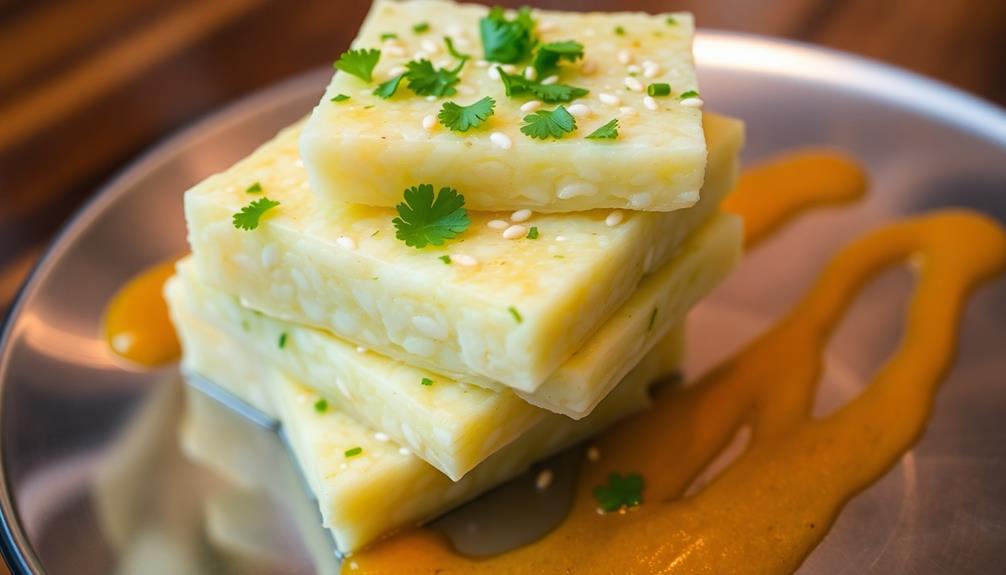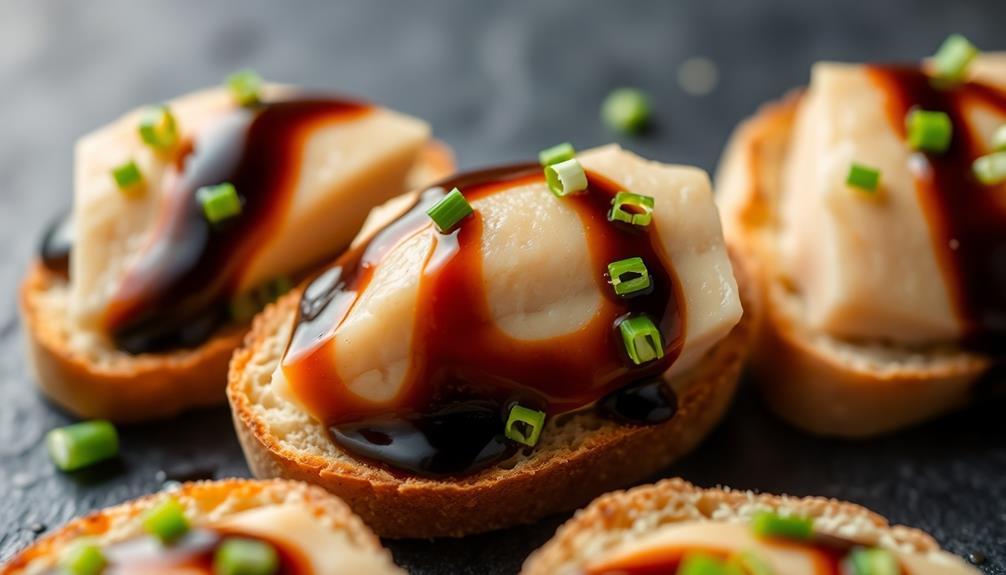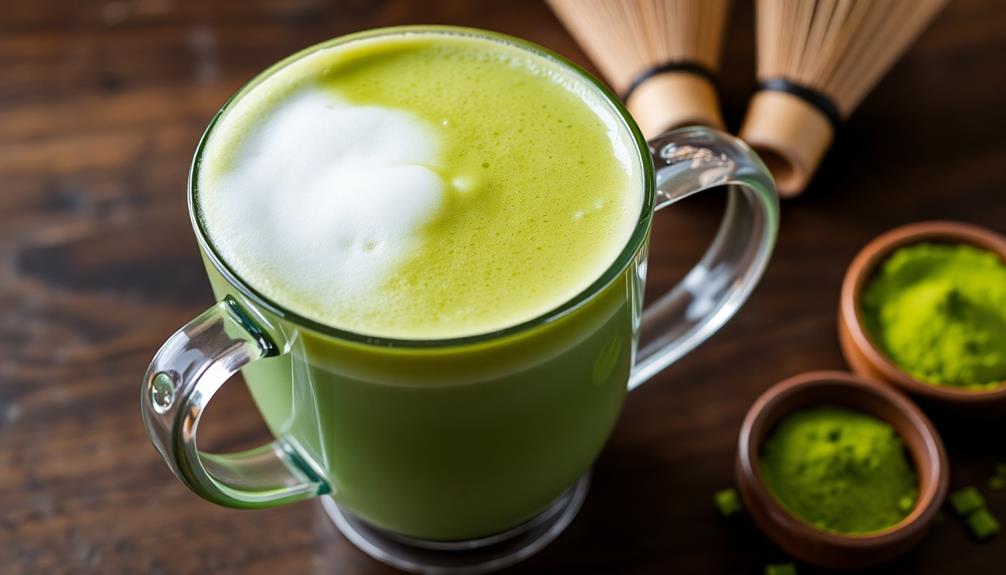You're probably familiar with onigiri, those delightful Japanese rice balls that have become a beloved staple around the world. But did you know they were originally created as portable meals for laborers and travelers? These versatile snacks are more than just a quick bite – they represent the comfort and community of homemade cooking. From the classic seaweed-wrapped onigiri to the creative fillings that invite personal expression, there's so much to explore in this humble yet captivating culinary tradition. Intrigued? Let's dive deeper into the history, recipes, and cultural significance of onigiri – you might be surprised by what you discover.
Key Takeaways
- Onigiri are Japanese rice balls that evolved from portable meals for laborers and travelers into a beloved staple of Japanese cuisine.
- Onigiri are typically made with short-grain Japanese rice, and can be filled with various savory or sweet ingredients.
- The preparation of onigiri involves proper rice cooking, shaping, and optional wrapping in nori for enhanced flavor and presentation.
- Onigiri are often served with pickled vegetables, which provide a refreshing contrast to the rice balls.
- Making onigiri can be a mindful and creative cooking experience, allowing for personalization and reflection on Japanese food traditions.
History
Onigiri, the iconic Japanese rice balls, have a rich history dating back centuries. These beloved snacks originated as a practical way for laborers and travelers to carry a portable, filling meal.
Over time, onigiri evolved from simple balls of plain rice to intricate creations with a variety of savory fillings and seasonings.
In the Heian period (794-1185 CE), onigiri became a staple food for the aristocracy, with chefs crafting elaborate designs and using premium ingredients. Shaped into iconic triangles, half-moons, and other whimsical forms, onigiri were often wrapped in salty seaweed and served as part of formal meals and ceremonies.
Today, onigiri remain a beloved part of Japanese cuisine, enjoyed as a quick snack, picnic food, or lunchbox staple. Whether plain or filled, onigiri continue to delight with their satisfying flavors and portability, connecting modern-day Japanese to their rich culinary heritage.
Recipe
Onigiri, or Japanese rice balls, are a classic and versatile snack or meal. These portable, hand-shaped rice treats can be filled with a variety of savory or sweet ingredients, making them a beloved staple in Japanese cuisine.
The key to delicious onigiri lies in the perfect preparation of the rice. Using short-grain Japanese rice, such as sushi rice, ensures the right balance of stickiness and texture to hold the shape of the rice balls.
Ingredients:
- 2 cups short-grain Japanese rice
- 2 cups water
- 1 teaspoon salt
- Fillings of your choice (e.g., umeboshi, salmon, tuna, or natto)
- Nori seaweed sheets, for wrapping (optional)
To prepare the onigiri, first, cook the rice according to the package instructions. Once cooked, transfer the rice to a large bowl and mix in the salt. Allow the rice to cool slightly, until it's comfortable to handle.
Wet your hands with water and take a handful of the rice, about 1/4 cup. Gently shape the rice into a triangle, oval, or any desired form, making a well in the center. Fill the well with your chosen topping and continue shaping the rice around the filling until a compact ball is formed.
Repeat with the remaining rice and fillings.
For an extra touch, you can wrap the onigiri in nori seaweed sheets. This not only adds flavor but also helps to keep the shape and prevent the rice from drying out.
Serve the onigiri warm or at room temperature, enjoying the contrast of the fluffy rice and the savory or sweet fillings.
Cooking Steps
First, wash and cook the short-grain rice to perfection.
Next, shape the rice into bite-sized balls using your hands.
Then, make a small indent in the center and fill it with a sprinkle of seasoned salt.
Wrap the rice ball in a sheet of nori seaweed and serve your homemade onigiri alongside some pickled vegetables.
Step 1. Wash and Cook Short-Grain Rice
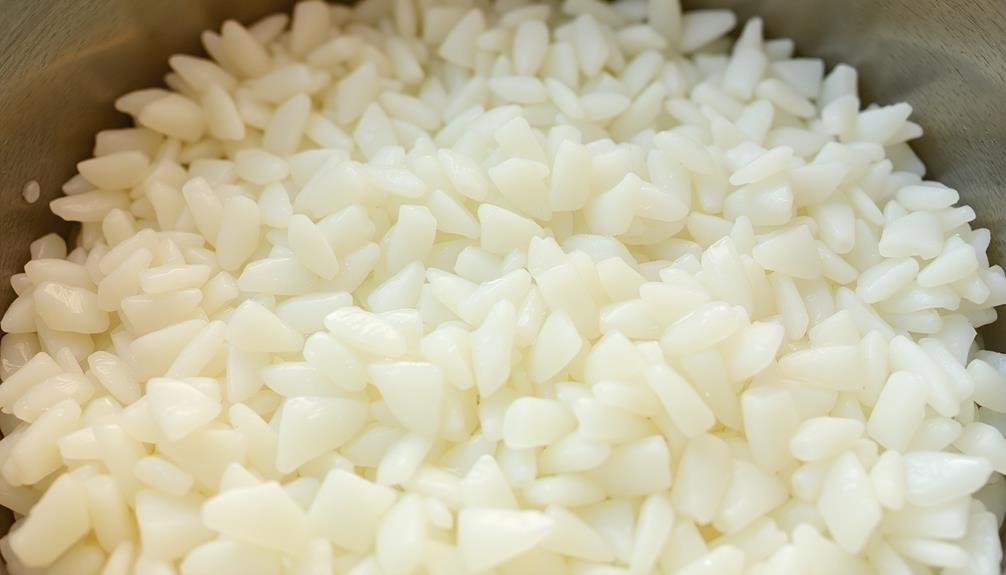
To prepare the rice for your onigiri, you'll want to thoroughly wash the short-grain rice. Start by placing the rice in a fine-mesh strainer and rinse it under cold running water, gently stirring the grains with your fingers. This helps remove any excess starch, ensuring your onigiri have a perfect, sticky texture.
Next, transfer the rinsed rice to a saucepan and add the appropriate amount of water. For every cup of rice, use 1 1/4 cups of water. Bring the mixture to a boil over high heat, then reduce the heat to low, cover the pan, and let the rice simmer for about 15 minutes.
Avoid lifting the lid during this time, as it can release precious steam and affect the cooking process.
Once the timer goes off, remove the pan from the heat and let the rice rest, covered, for an additional 10-15 minutes. This allows the grains to fully absorb the water, resulting in fluffy, cohesive rice perfect for shaping into your delightful onigiri.
Step 2. Shape Rice Into Balls
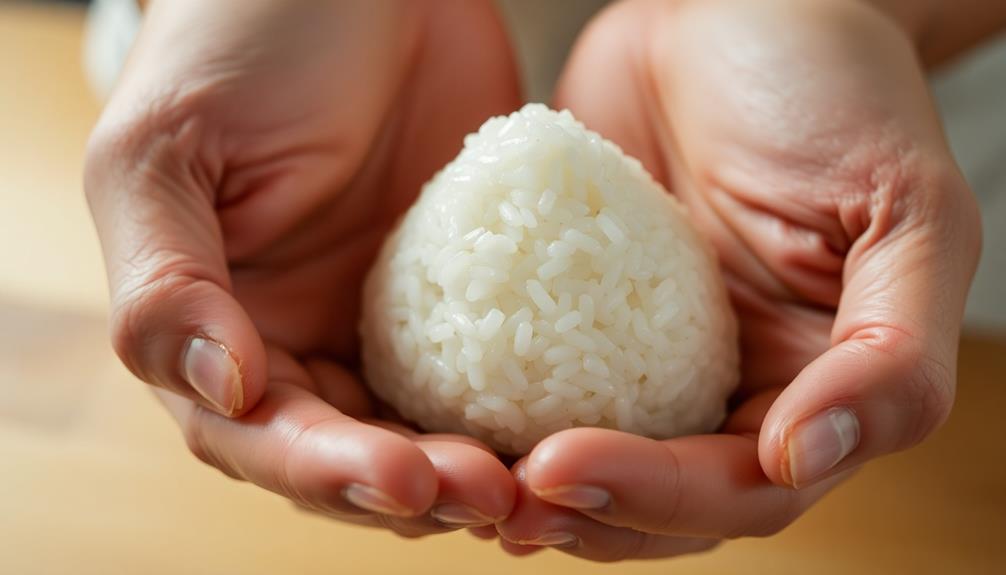
With your perfectly cooked short-grain rice, you're now ready to shape it into the classic onigiri.
First, wet your hands with a bit of water to prevent the rice from sticking. Grab a handful of rice and gently squeeze it into a tight ball, using your palms to smooth out the shape. If you'd like, you can add a filling, such as umeboshi (pickled plum), salmon, or any savory ingredient you enjoy. Simply place a small amount in the center of the rice and mold the ball around it.
Next, use your fingers to create a triangular or rounded shape, depending on your preference. Onigiri can be as simple or elaborate as you'd like.
For a decorative touch, you can wrap the rice ball in a sheet of nori (seaweed) or sprinkle it with furikake (seasoned salt). The possibilities are endless! With a little practice, you'll be shaping delightful onigiri in no time.
Step 3. Fill With Seasoned Salt
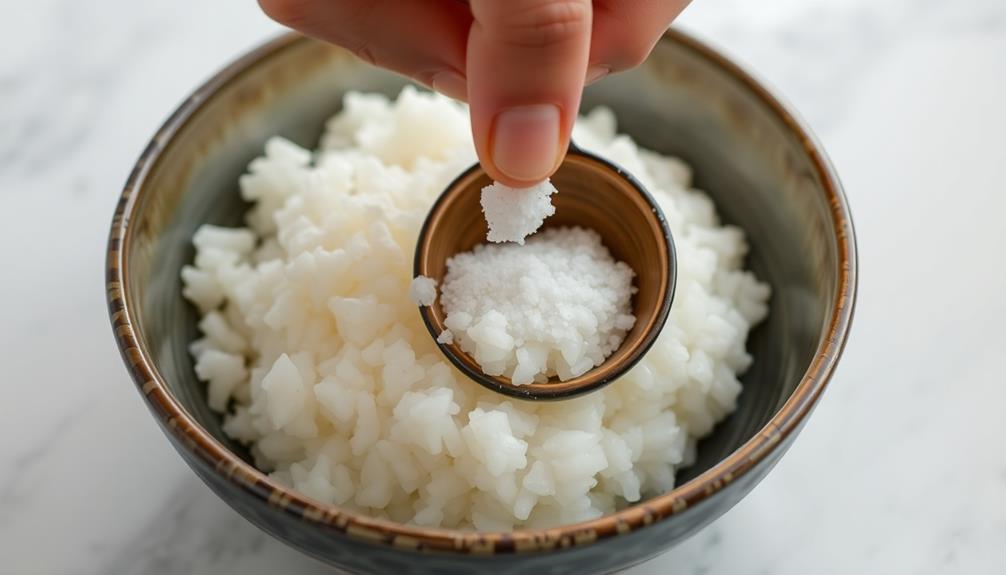
Sprinkle a pinch of furikake (Japanese seasoned salt) over the formed onigiri. This seasoned salt adds a savory, umami-rich flavor to your rice balls.
Gently press the furikake into the surface to help it adhere. You can find furikake in the Asian section of your grocery store or at an Asian market.
For a classic filling, place a small amount of pickled plum (umeboshi) or a dab of miso paste in the center of the onigiri before sealing.
Experiment with other fillings too, like cooked chicken, tuna salad, or a savory vegetable mixture. Just be sure not to overstuff the onigiri, or they may fall apart.
Once filled, wet your hands again and gently shape the onigiri into tight, uniform balls. The moisture helps the rice stick together.
Serve the seasoned onigiri as a snack, side dish, or part of a bento box lunch. Enjoy these flavorful and satisfying Japanese rice balls! If you’re looking for a traditional Japanese way to enjoy your leftover onigiri, try pairing it with a simple ochazuke recipe. Ochazuke is a comforting dish made by pouring hot green tea over rice and topping it with various savory ingredients like pickles, seaweed, or even a piece of grilled fish. It’s a wonderful way to turn your onigiri into a complete and satisfying meal. So whether you’re enjoying it as a snack or as part of a bento box lunch, onigiri is sure to be a delicious and versatile addition to your Japanese cuisine repertoire.
Step 4. Wrap Rice Ball in Nori Seaweed
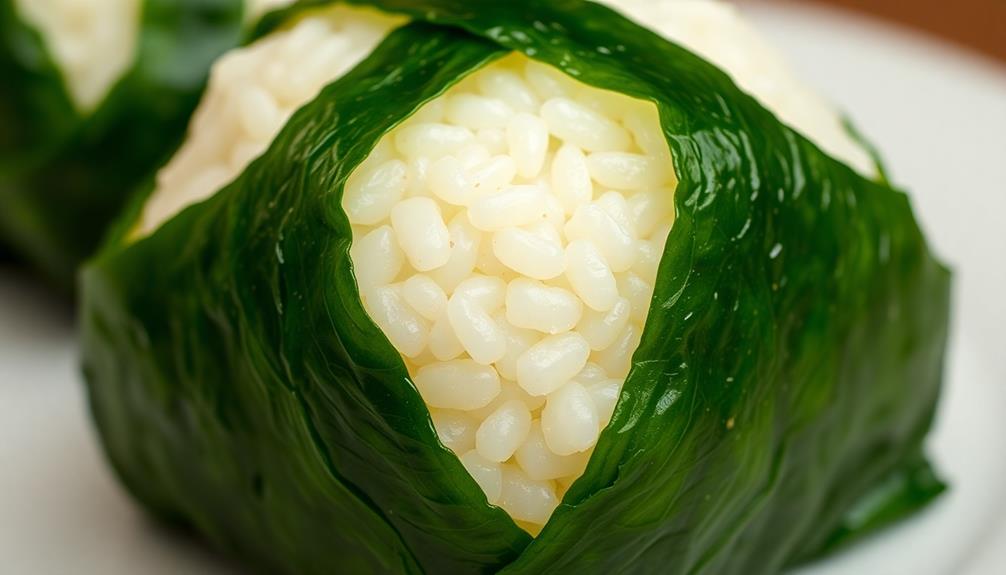
For a visually appealing presentation, consider wrapping the formed onigiri in a sheet of nori (dried seaweed).
Start by placing the rice ball in the center of a square piece of nori. Gently press the nori around the rice, molding it to the shape of the onigiri. Ensure the nori fully covers the rice, overlapping slightly. You can use a small amount of water to help the nori adhere to the rice if needed.
Once wrapped, you can lightly squeeze the onigiri to secure the nori in place. This step not only enhances the aesthetics of your onigiri but also adds a delightful crunch and savory flavor from the nori.
Feel free to experiment with different sizes and shapes of nori to suit your preferences. Wrapping the onigiri in nori is a simple yet effective way to elevate the presentation and enjoyment of this traditional Japanese treat.
Step 5. Serve Onigiri With Pickled Vegetables
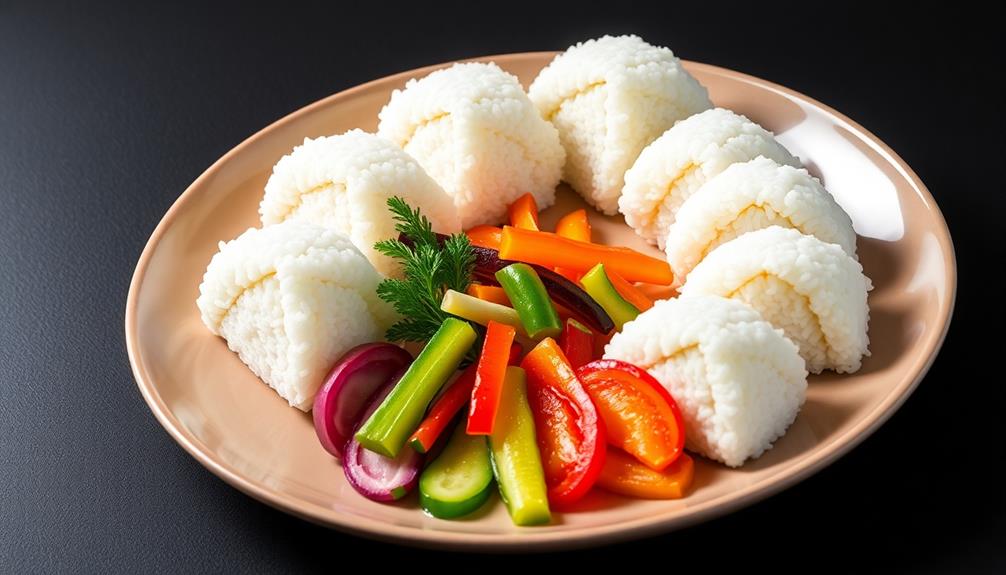
To elevate your onigiri experience, consider serving them alongside a selection of pickled vegetables. Pickled veggies provide a tangy, crunchy contrast that complements the savory rice balls. Popular options include daikon radish, carrots, and cucumber, all infused with a vinegary brine.
Start by preparing your pickled vegetables in advance. Thinly slice the vegetables, then submerge them in a mixture of rice vinegar, sugar, and salt. Allow the flavors to meld for at least 30 minutes, or up to a week in the refrigerator.
When ready to serve, drain the pickled veggies and arrange them artfully alongside your freshly made onigiri. The brightness and acidity of the pickled produce will refresh the palate, cutting through the richness of the rice.
Encourage guests to top their onigiri with a few pieces of the tangy, crunchy pickles for a delightful textural and flavor contrast. This simple addition elevates the humble rice ball into an even more memorable and well-rounded snack or side dish.
Final Thoughts
Onigiri, these beloved Japanese rice balls, encompass a world of flavors and traditions. As you've discovered, creating these delightful snacks is a rewarding experience, allowing you to explore the rich culinary heritage of Japan.
Whether you prefer the classic seaweed-wrapped varieties or the playful character-shaped ones, each bite offers a unique blend of textures and tastes.
Beyond the sheer enjoyment of making and eating onigiri, these rice balls hold a deeper significance. They're often shared during special occasions, fostering a sense of community and celebration.
Crafting onigiri can be a mindful activity, a way to connect with the traditions of Japan and appreciate the simple pleasures of homemade food.
As you continue your onigiri journey, remember to experiment with different fillings, shapes, and presentation styles.
Embrace the creativity and personalization that these versatile snacks allow. Savor each moment, for in the world of onigiri, the possibilities are as endless as the joy they bring.

